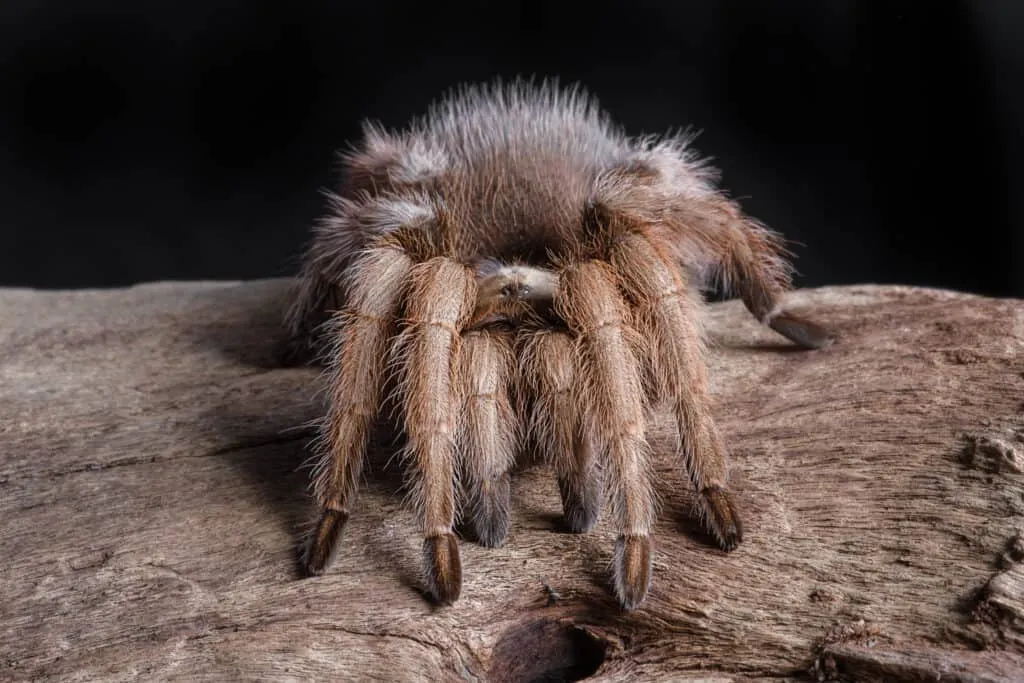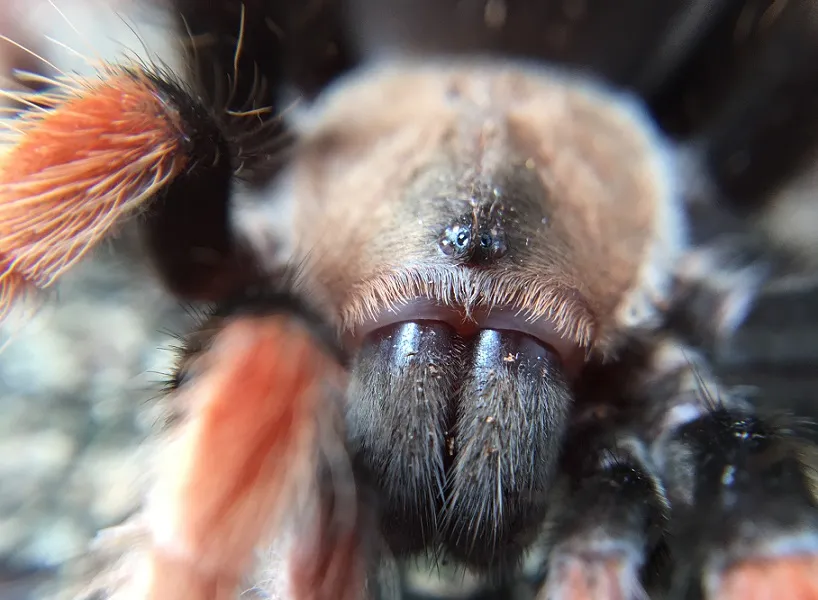What are Tarantulas?
Tarantulas are large, hairy spiders belonging to the Theraphosidae family. They are known for their impressive size, often with leg spans reaching over 10 inches, and their diverse coloration. Found in various habitats worldwide, from tropical rainforests to deserts, tarantulas are primarily nocturnal creatures, preferring to hunt at night. These spiders are generally not aggressive towards humans, but they possess several defense mechanisms, including the ability to bite. Tarantulas are not insects; they are arachnids, meaning they have eight legs, two body sections (cephalothorax and abdomen), and lack antennae. The word tarantula originates from the tarantula wolf spider, which was thought to cause a condition called tarantism. The tarantula is a popular pet, but it requires special care and handling.
Tarantula Bite Mechanism
Tarantulas bite using fangs called chelicerae. These fangs are located at the front of the cephalothorax and are used to inject venom into their prey or, in some cases, a perceived threat. The chelicerae are typically strong and capable of piercing the skin. When a tarantula bites, it quickly strikes with its fangs, injecting venom into the target. The venom contains a cocktail of toxins designed to paralyze or subdue the prey. The bite mechanism involves a swift downward strike with the fangs. The size and shape of the fangs vary depending on the tarantula species, with some having longer or more robust fangs than others. This is a defensive mechanism and tarantulas will not bite humans unless they feel threatened.
How Tarantulas Bite

Tarantulas bite in self-defense or to capture prey. They are not naturally aggressive towards humans and will typically try to escape or use other defensive behaviors like flicking urticating hairs before resorting to biting. If a tarantula feels threatened, such as when handled roughly or cornered, it may bite as a last resort. The bite involves the tarantula quickly lunging forward and using its chelicerae to pierce the skin. The fangs, which are sharp and strong, penetrate the skin, injecting venom. The venom itself is not generally lethal to humans. However, the bite can be painful, and the venom may cause local reactions. The likelihood of being bitten is low if one is careful and avoids provoking the tarantula.
The impact of a Tarantula Bite
The impact of a tarantula bite on humans varies depending on several factors, including the species of tarantula, the amount of venom injected, and the individual’s sensitivity. Generally, tarantula bites are not considered life-threatening to humans. However, they can cause localized symptoms such as pain, redness, swelling, and itching at the bite site. Some people may experience more severe reactions, including muscle cramps, nausea, and sweating. The venom of most tarantula species is relatively mild and primarily causes discomfort rather than serious harm. However, individuals with allergies or sensitivities to insect venom may experience more pronounced reactions. Seeking medical attention is recommended if you experience severe symptoms or if the bite site shows signs of infection.
Are Tarantulas Bites Dangerous?
While tarantula bites are not usually life-threatening, they can be uncomfortable and potentially cause health problems. The level of danger depends on the species of tarantula and the individual’s reaction. Most tarantula bites result in mild to moderate symptoms. However, some bites may lead to more severe reactions, particularly in individuals with allergies or sensitivities. Secondary infections at the bite site are another concern. The fangs can introduce bacteria, leading to infections that may require medical treatment. Seeking prompt medical attention is essential if you experience severe symptoms like difficulty breathing, significant swelling, or signs of infection. It is very rare for a tarantula bite to be fatal to humans.
Symptoms of a Tarantula Bite

The symptoms of a tarantula bite can vary but usually involve localized effects. Common symptoms include immediate pain at the bite site, often described as a sharp or burning sensation. Redness and swelling around the bite are also typical, as the body reacts to the venom. Itching is another common symptom, along with possible muscle cramps and spasms. Some individuals may experience nausea, sweating, and increased heart rate. More severe reactions are rare but possible, especially in sensitive individuals. These include difficulty breathing, severe swelling, or signs of an allergic reaction. If you experience any of these serious symptoms, seek immediate medical attention. The duration of the symptoms varies, but most resolve within a few days.
How to treat a Tarantula Bite
Treatment for a tarantula bite focuses on managing symptoms and preventing complications. First, wash the bite area gently with soap and water. Apply a cold compress to reduce swelling and pain. Over-the-counter pain relievers, such as ibuprofen or acetaminophen, can help manage pain. Antihistamines may alleviate itching and reduce allergic reactions. Elevate the affected limb to minimize swelling. It’s essential to monitor the bite site for signs of infection, such as increased redness, pus, or fever. If the symptoms worsen or if you experience severe reactions like difficulty breathing or significant swelling, seek immediate medical attention. In most cases, treatment is aimed at providing relief from the discomfort and preventing secondary infections.
First Aid Steps
If bitten by a tarantula, take these first aid steps promptly. First, stay calm and move away from the tarantula to avoid further bites. Clean the bite area thoroughly with soap and water. Apply a cold compress or ice pack to reduce swelling and pain. Keep the affected limb elevated to minimize swelling. Monitor the bite site for signs of infection or worsening symptoms. Over-the-counter pain relievers can help manage pain. If you experience severe symptoms like difficulty breathing, significant swelling, or signs of an allergic reaction, seek immediate medical attention. Note the tarantula’s appearance, if possible, to help with identification and treatment. This information can be helpful for medical professionals. Avoid applying a tourniquet or trying to suck out the venom, as these methods are ineffective.
When to Seek Medical Attention

Seek medical attention immediately if you experience severe symptoms after a tarantula bite. These symptoms include difficulty breathing, chest pain, severe swelling, dizziness, or loss of consciousness. Also, seek medical care if the bite site shows signs of infection, such as increased redness, pus, fever, or if you notice red streaks spreading from the bite. If you develop an allergic reaction, such as hives, itching all over the body, or swelling of the face or throat, seek medical help without delay. People with pre-existing health conditions, allergies, or sensitivities to insect venom should also seek medical evaluation. It’s always best to err on the side of caution and consult a healthcare professional if you have any concerns about a tarantula bite.
Preventing Tarantula Bites
Preventing tarantula bites is crucial, especially if you live in an area where tarantulas are common or keep them as pets. When handling tarantulas, always wear gloves and long sleeves to protect your skin. Handle tarantulas cautiously and avoid sudden movements that could startle them. Never put your hands near a tarantula’s fangs. If you encounter a tarantula in the wild, observe it from a distance. Avoid provoking or cornering the spider. Keep your living spaces clean and free of clutter, as this can provide hiding places for tarantulas. Regularly inspect your home for potential entry points, such as cracks in walls or around windows, and seal them. If you have tarantulas as pets, ensure their enclosure is secure and properly maintained to prevent escape.
Where do Tarantulas Live?
Tarantulas live in various habitats around the world, primarily in warmer regions. They are found in North and South America, Europe, Africa, Asia, and Australia. Their habitats range from tropical rainforests and grasslands to deserts and woodlands. They are typically terrestrial, living on the ground in burrows or under rocks and logs. Some species also live in trees or shrubs. Tarantulas are well-adapted to their environments, often camouflaging themselves to blend in with their surroundings. The specific habitats of tarantulas vary depending on the species. The presence of tarantulas is also influenced by the availability of food, such as insects, and suitable places to build their homes.
Handling Tarantulas Safely

Handling tarantulas should be done with caution, as they can bite if they feel threatened or are startled. When handling, always wear gloves to protect your skin. Use a long pair of tongs or a similar tool to move the tarantula if needed. Avoid sudden movements and try to handle the tarantula in a calm, slow manner. Never attempt to handle a tarantula that appears aggressive or agitated. Handle the tarantula over a soft surface, such as a bed or a carpeted area, in case it falls. Always supervise children when they are near tarantulas. If you’re unfamiliar with handling tarantulas, it’s best to observe an experienced handler first.
Conclusion
In summary, tarantulas can bite humans, but the bites are rarely life-threatening. Understanding the bite mechanism, potential symptoms, and proper treatment can help you handle these spiders safely and respond effectively if bitten. While the thought of a tarantula bite may be unsettling, most bites result in mild discomfort. By taking precautions and knowing what to do, you can minimize the risks. If you’re a tarantula enthusiast, proper handling techniques and awareness of their behavior are critical. If you are bitten and experience severe symptoms, seek medical help immediately. Always respect the power of these creatures.
